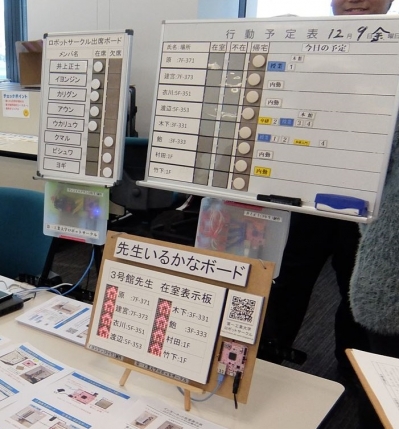Title:Internet-based Attendance Board
Displayed Name:Robot Circle (Group 1), Daiichi Institute of Technology

| Concept / Overview |
|---|
| We created an Internet-linked, 3-unit set of attendance display boards. - Unit 1 (Robot circle attendance board) - Unit 2 (Faculty calendar) - Unit 3 (Faculty attendance board) |
Gadget Concept & Description
We created an Internet-linked, 3-unit set of attendance display boards.
- Unit 1 (Robot circle attendance board)
- Unit 2 (Faculty calendar)
- Unit 3 (Faculty attendance board)
Unit 1 is a whiteboard displaying attendance information for circle members. An SD card reads the date and time when a magnet is moved. The board functions as an HTTP server, so any browser can read information on members’ current and past attendance. The log of past attendance is useful in understanding members’ current activity.
Unit 2 is operated as an Ethernet client, posting faculty locations on Unit 3 (HTTP server). Information on attendance gleaned from Unit 2 is displayed on the Unit 3 matrix using LED. As it functions as an HTTP server, this can also be read by a browser.
The Idea & Happy Users
1. Target users: students and faculty
2. Required background information:
The university has several buildings. One can only determine if a faculty member is in his or her office by checking the attendance board on the first floor of the relevant building. Linking that information to the Internet (personal computer or smartphone browser) allows one to check faculty locations without travelling to another building. The faculty member need only move his or her magnet upon entering or departing the office building.
3. Functions:
The “name columns” on the Unit 1 and Unit 2 whiteboards each have two pressure sensors. The sensors convert the resistance value when they sense the pressure of a magnet attaching to the board, and the signal is read by the GR-SAKURA AD converter. Then GR-SAKURA’s HTTP server and HTTP client are used for the Internet to read the attendance information from the whiteboard. GR-SAKURA’s RTC and SD card functions are used to record the date and time of entry to/departure from the building. The browser allows users to adjust times and access past attendance data logs. Unit 3 displays attendance information without a browser, allowing students to know their advisor’s location the moment they arrive at the university.
Results Achieved as of Contest Judging
All aspects of project development were completed.
Detailed documentation is available at:
URL: http://robot-dit-ueno.blogspot.jp/2016/10/blog-post_25.html
Demo Video
GR Design Contest 2016 Finalist

